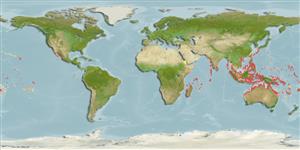>
Eupercaria/misc (Various families in series Eupercaria) >
Labridae (Wrasses) > Cheilininae
Etymology: Cymolutes: Greek, kymo = waves + Greek, lytes, lyto = to liberate.
More on author: Valenciennes.
Environment: milieu / climate zone / depth range / distribution range
Ecología
marino asociado a arrecife; rango de profundidad 2 - 20 m (Ref. 37816), usually 6 - ? m (Ref. 48636). Tropical; 32°N - 32°S
Indo-Pacific: East Africa to New Britain and the Marquesan (?) Islands, north to southern Japan, south to Lord Howe Island.
Tamaño / Peso / Age
Maturity: Lm ? range ? - ? cm
Max length : 20.0 cm TL macho / no sexado; (Ref. 48636)
Espinas dorsales (total): 9; Radios blandos dorsales (total): 9-12; Espinas anales 2-3; Radios blandos anales: 9 - 12. Differs from C. praetextatus by having 12 instead of 13 dorsal rays, dark brown markings on the head and body, and lacking the small black spot on the upper base of the caudal fin (Ref. 1602).
A solitary species (Ref. 90102) common over sandy areas of reef flats and shallow sandy lagoons to a depth of at least 6 m. Also found in estuaries. Feeds on benthic invertebrates (Ref. 89972). Usually in current zones such as tidal channels. Juveniles often with small outcrops of rubble and algae or around the edges of sparse seagrasses (Ref. 48636). The species is capable of diving into sand when threatened.
Life cycle and mating behavior
Madurez | Reproducción | Puesta | Huevos | Fecundidad | Larva
Oviparous, distinct pairing during breeding (Ref. 205).
Randall, J.E., G.R. Allen and R.C. Steene, 1990. Fishes of the Great Barrier Reef and Coral Sea. University of Hawaii Press, Honolulu, Hawaii. 506 p. (Ref. 2334)
IUCN Red List Status (Ref. 130435)
Threat to humans
Harmless
Human uses
Más información
ReferenciasAcuiculturaPerfil de acuiculturaRazasGenéticaElectrophoresesheritabilidadEnfermedadesProcesamientoNutrientsMass conversion
ColaboradoresImágenesStamps, Coins Misc.SonidosCiguateraVelocidadTipo de nataciónSuperficie branquialOtolitosCerebrosVisión
Herramientas
Special reports
Download XML
Fuentes de Internet
Estimates based on models
Preferred temperature (Ref.
123201): 24.6 - 29.3, mean 28.3 °C (based on 2575 cells).
Phylogenetic diversity index (Ref.
82804): PD
50 = 0.6250 [Uniqueness, from 0.5 = low to 2.0 = high].
Bayesian length-weight: a=0.00389 (0.00180 - 0.00842), b=3.12 (2.94 - 3.30), in cm total length, based on all LWR estimates for this body shape (Ref.
93245).
Nivel trófico (Ref.
69278): 3.6 ±0.5 se; based on size and trophs of closest relatives
Resiliencia (Ref.
120179): Medio, población duplicada en un tiempo mínimo de 1.4-4.4 años (Preliminary K or Fecundity.).
Fishing Vulnerability (Ref.
59153): Low vulnerability (10 of 100).
